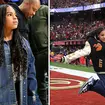The North East Goes Digital
11 September 2012, 05:00 | Updated: 30 March 2016, 13:50
The final part of the switchover is taking place. We've got all the info you need to make sure you're ready to make the switch.
Transmitters across the North East will start to switch over from analogue to digital over the next fortnight - starting from Wednesday 12th September.
That means you need a freeview TV or digital box to keep getting all your channels.
Click HERE for a step by step guide to helping you switchover.
What is digital TV switchover?
Switchover is the process of converting the UK's terrestrial television system to digital.
Between now and 2012, analogue channels broadcast from more than a thousand transmitter sites are being switched off region by region and replaced with Freeview digital TV and radio services.
Why is it happening?
Households in many parts of the UK are currently unable to receive Freeview services.
Switching off the existing analogue broadcasting system will create the capacity necessary to extend coverage to the whole country. Broadcasting in digital format is also a more efficient way to transmit television signals and will free up airwaves for new services such as ultra-fast wireless broadband and mobile television.
What happens at switchover and what do I need to do?
Switchover is a two-stage process.
At stage one, BBC Two will cease broadcasting in analogue and BBC digital channels will become available for the first time to viewers watching local 'relay' transmitters.
At stage two, the remaining analogue channels will be permanently switched off and replaced with additional digital services.
All Freeview, BT Vision and Top Up TV viewers will need to retune their equipment at both stages of switchover. Most people have already converted their main TV to digital.
Viewers must ensure that their TVs are capable of receiving a digital signal in order to continue receiving television services after switchover.
Virtually any TV, even black and white ones, can be converted with a digital box. Anyone buying new TV equipment should look for the 'digital tick' logo which identifies equipment designed to work through switchover.
What are the different ways to get digital TV?
There are three main options for going digital: Convert your existing TV with a digital set-top box (eg Freeview, Top Up TV, BT Vision*) Get a service like satellite or cable TV installed for you (eg Sky, Freesat, Virgin Media, Wight Cable or SmallWorld) Get a new TV with digital built-in (eg Freeview, Freesat)
*Requires broadband connection
How much does digital television cost?
For those getting digital for the first time or who are converting secondary sets around the home, the cost will vary according to the number of TVs and method of conversion.
It's estimated that 5-10 per cent of households may need to replace damaged aerials in order to receive Freeview signals.
* Freeview digital boxes start from around £20
* Digital televisions start from around £150
* Freesat from Sky costs approximately £175 (includes installation)
* Freesat from the BBC/ITV costs from £30 for a digital box, £450 for a digital TV.
* Satellite dish installation (if required) from £80 Subscriptions (e.g. Sky, Virgin, Top Up TV) start from approximately £10 per month
* Digital television recorders cost from around £80 A standard new roof aerial normally costs £60-180
What channels will viewers get?
Switchover will make Freeview television channels available across the UK.
Viewers choosing to get digital television this way will be able to receive BBC One, BBC Two, ITV1, Channel 4 and Channel 5 plus a range of digital channels and services free via an aerial.
Channel availability depends on where you live and which transmitter you get your signal from. Broadcasters may also change their line-up from time to time. Most households will be able to receive more than 40 Freeview channels via an aerial; around 15 of the most popular channels will be available elsewhere.






